The first lady of animation is celebrated with two unusual children’s recordings, made generations apart, both as ageless as the talent of June Foray herself.
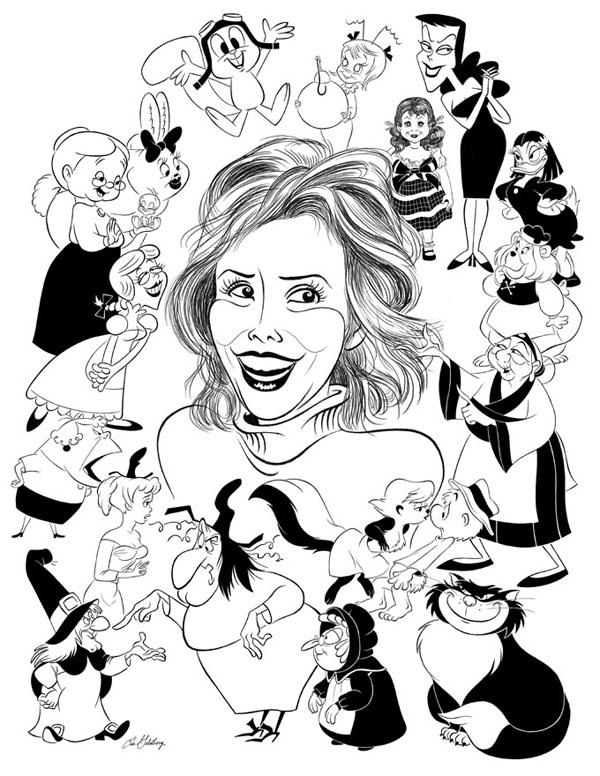
SPARKY AND THE MAGIC BATON
Capitol Records – Children’s Series (10” 78 RPM / Mono / Also on 45 RPM)
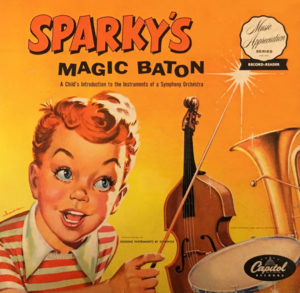
Released in 1947. Producer: Dave Cavanaugh. Story: Bob Willheim. Adaptation: Alan W. Livingston. Music: Billy May. Running Time: 13 minutes.
Voices: June Foray (Sparky); Art Gilmore (Narrator); Daws Butler (Conductor); Singing Instruments by Sonovox.
June Foray would be 101 today. We said goodbye to her last year (Eric Goldberg created the above art for her remembrance celebration program cover). She’ll never leave us in spirit or voice, of course.
Most tributes to June Foray list the usual voices: Rocky, Nell Fenwick, 99.9% of the female Jay Ward characters, Granny, Witch Hazel, Cindy Lou Who, Jokey Smurf, maybe the “Baby! Baby! Baby!” lady, and so forth. Today’s we’re a little more obscure.
June Foray was one of the stock players for the Capitol Children’s Series at the same time she worked with Stan Freberg on his records, often with the same creative team—Daws Butler and the music of Billy May—and probably the same musicians in bookended sessions. It was a golden time for all of these records.
The Capitol children’s discs are largely remembered for their licensed character titles, like Looney Tunes/Merrie Melodies, Woody Woodpecker and Disney. Capitol also gave the world Bozo the Clown, who was a Capitol Records character before being sold into Larry Harmon’s TV franchise machine.
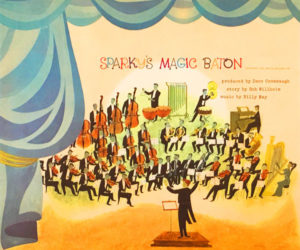 Lesser known, but also significant, are the “Sparky” records. Sparky’s records became very successful before he appeared in animation (he did occasionally appear in comic books with Bozo).
Lesser known, but also significant, are the “Sparky” records. Sparky’s records became very successful before he appeared in animation (he did occasionally appear in comic books with Bozo).
June Foray is heard on Sparky’s first album, Sparky and the Talking Train (1947). Narrator Marvin Miller (Sleeping Beauty, The Pink Panther Show) introduces Sparky as a youngster taunted by his schoolmates–one of which is played by June–because they can’t hear the trains talking as he can. Eventually Sparky’s strange ability helps him save a train from crashing. Then all the reindeer love him. Marvin Miller tells us, “Even the other children now liked Sparky because he was so famous.” Timely, huh?
The original Sparky was Henry Blair, the radio voice of Ricky Nelson for the first four seasons of The Adventures of Ozzieand Harriet (David was played by Joel Davis and then Tommy Bernard). In the fifth season, the real-life Ricky and David began to portray themselves, at their own insistence.
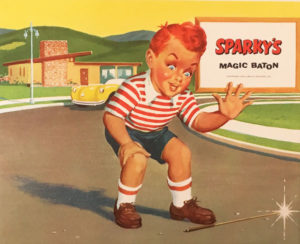 The second album, Sparky’s Magic Piano (1948) is the most famous of the series, especially in the UK. It became a beloved tradition on Ed “Stewpot” Stewart’s BBC Radio Junior Choice program for decades.
The second album, Sparky’s Magic Piano (1948) is the most famous of the series, especially in the UK. It became a beloved tradition on Ed “Stewpot” Stewart’s BBC Radio Junior Choice program for decades.
This one is a Twilight Zone-like story in which Sparky complains about his piano lessons—predating Dr. Seuss’ The 5,000 Fingers of Dr. T by five years. His piano begins to speak, saying it will play for him. Sparky becomes a big success until the piano decides to stop and Sparky is humiliated in front of a huge concert audience. Awakened from this nightmare, Sparky learns he has to practice.
This album was so successful, Livingston reused the storyline on other albums, including another with Blair called Rusty in Orchestraville (1949). June Foray and Mel Blanc can be heard on 1956’s Jack Benny Fiddles with the Classics (a.k.a. Jack Benny Plays the Bee), in which the comic violinist tells the “magic instrument” story as if it happened to him as a child:
Success turns Sparky into a spoiled brat in the animated feature version, which may have been intended as a TV special in 1982, but was released direct-to-video in 1987. The original Capitol Records producer, Alan Livingston, co-produced this adaptation, which was directed by Lee Mishkin of DePatie-Freleng, UPA, TTV and H-B. It’s narrated by William Schallert with the voices of Mel Blanc, Vincent Price, Tony Curtis, Cloris Leachman and even Livingston’s wife, Oscar-nominee Nancy Olson (Sunset Boulevard, Pollyanna).
The plot of Sparky’s Magic Piano is astonishingly similar to that of a season five episode of I Dream of Jeannie, “Jeannie at the Piano.”
June Foray finally became Sparky in 1954, with the “Record Reader” album Sparky’s Magic Baton,” with her old friend Daws Butler as the conductor. The Record Reader format had no text, just lush illustrations that the listener looked at as the record played. This is a comparatively pleasant romp for Sparky, without the angst of nasty peers or taunting audiences.
There was other female who played Sparky, singer Lee LeDoux, for the shorter and more lyrical Sparky’s Magic Echo (1952). It was produced by Mel-O-Toons, a small maker of educational films which often adapted audio recordings for their very limited animation. In 1960, they released it as Sparky’s Magic Voice.
The Sonovox electronic transmission device, by the way, was used for all these records, as well as for Casey Jr. in Walt Disney’s Dumbo. It was demonstrated by actor Frances Gifford for Robert Benchley in The Reluctant Dragon. Bandleader Kay Kyser starred in a very strange short that featuring the Sonovox.
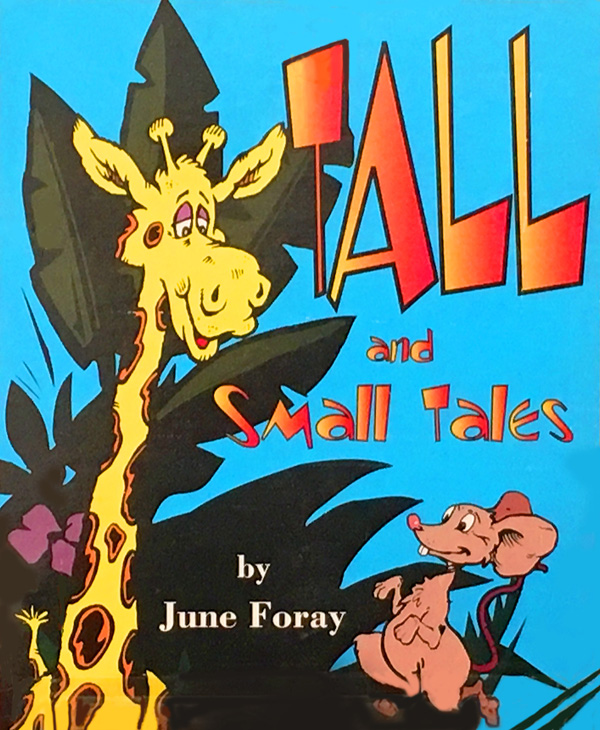
TALL AND SMALL TALES
BY JUNE FORAY
Helion Audio Books (Cassette)
Released in 1997. Producers: Greg Knowles, June Foray. Associate Producer/Composer: Miriam Cutler. Engineer: Van Webster. Cover Design: Wesco Graphics. Running Time: 55 minutes.
Stories: “Timothy in Mother Goose Land,” “Witch Chucklechin and the Moon’s Dirty Face,” “Fergus, the Fly-by-Night Flea,” “Sean and the Leprechaun,” “T-Bone Turtle” by June Foray.
When June Foray was not acting, crusading for other actors, campaigning in political activities, changing the course of show business or otherwise making the world better for having lived in it, she wrote.
Tall and Small Tales was something she created to showcase the range of her voice acting talents, as well as her sense of whimsy and warmth. So much of her work was for children, it stands to reason that more of us—and we’re all the kids who loved and love her—should know these unpretentious tales that set out simply to entertain.
“June Foray’s Tall and Small Tales”
As a special treat for June’s birthday, here are her charming original stories, told with her inimitable voices.
Here are all five.


 GREG EHRBAR is a freelance writer/producer for television, advertising, books, theme parks and stage. Greg has worked on content for such studios as Disney, Warner and Universal, with some of Hollywood’s biggest stars. His numerous books include Mouse Tracks: The Story of Walt Disney Records (with Tim Hollis). Visit
GREG EHRBAR is a freelance writer/producer for television, advertising, books, theme parks and stage. Greg has worked on content for such studios as Disney, Warner and Universal, with some of Hollywood’s biggest stars. His numerous books include Mouse Tracks: The Story of Walt Disney Records (with Tim Hollis). Visit 





















































I have ‘Magic Piano’ on a cassette I bought in the early ’80’s. Had no idea it was done in the ’40’s!
The “very strange short” with Kay Kyser is a section of his 1940 feature “You’ll Find Out.” Bela Lugosi, playing a phony psychic, also gets to use the Sonovox in the course of the film.
And don’t forget Boris Karloff and Peter Lorre ar also in the picture.
Looking at Ish Kabibble as a first-draft Lloyd Christmas, it’s hard to believe he went to law school and served as the band’s business manager.
Wow, wotta memory jolt. Forgotten until now, I had Sparky records as a kid (1950s). The visuals for Train and Piano are crystal clear, but when I Youtube’d them just now, none of the audio rang a bell. Which is odd, as I’m even more of a music junkie than a toon junkie.
Oh well – – – thanx, Greg, and happy birthday June!
The Sonovox is similar to the “talk box” used by guitarist Peter Frampton on several studio albums and then on his monster “Comes Alive” album.
A hand-held device similar to the Sonovox is used by people who have lost their larynx.
I think the Sonovox was briefly used in “Clock Cleaners” (1937) where an uncooperative coil argues with Donald.
The Sonovox in all its surrealistic glory.
Pete Drake went on to become quite an influential guy in the music industry.
https://www.youtube.com/watch?v=_R9an8AU3No